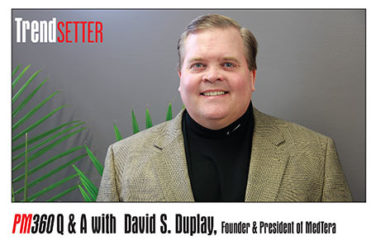Social media has always been tricky when it comes to pharma. And one of the reasons why the industry was so slow to embrace the medium is the potential issues that can arise when people are discussing a topic in real time. What should and shouldn’t a company respond to? How much are they allowed to say? What happens if someone starts talking about adverse events? Should companies even allow comments in the first place?
Despite those concerns, we have seen several pharma companies start to embrace social media over these past few years. And one standout example has been UCB’s Epilepsy Advocate program, which includes a Facebook community that has steadily grown over the five years since its launch. But it wasn’t until recently that UCB decided to test unknown waters—real-time engagement.
Last October, the company conducted its first ever live Q&A session. The Facebook community was opened up for questions as Chris M., an epilepsy patient advocate, offered his responses in real time to more than 1,000 engaged Facebook users. Greg Cohen, Sr. Manager, Social Media & Influence at UCB, spoke with PM360 about how the company pulled this off and how their social media strategy has evolved over the years.
PM360: Can you start off by just describing UCB’s Epilepsy Advocate program as a whole, and then how the company handles the social media presence?
Greg Cohen: The Epilepsy Advocate program is an ecosystem consisting of online, print and live-interaction activities across a variety of media. UCB created the program in collaboration with a team of advocates, people living with epilepsy and caregivers, who share a goal of inspiring individuals in the epilepsy community to seek the best possible care and make positive changes in their lives.
UCB has a team dedicated to managing the program, including the Facebook community, and all of its content. That team includes members from UCB’s epilepsy commercial team, Public Relations/Advocacy, Social Media, IT and agency partners, as well as a group of advocates who lend their insights and personal experiences to every aspect of the program.
What type of content do you try to provide on the Facebook page and what has been the reaction to the different types of content?
UCB’s legacy in epilepsy and our integration of patients in the Epilepsy Advocate program has supported the development of strategic pillars which guide the content on our site. These pillars are based on ongoing input from Epilepsy Advocates and the daily feedback we receive from our more than 110,000 Facebook fans. Additionally, we use our epilepsy experts from within UCB: The medical team who have studied the science of epilepsy, the market research team who have developed insights based on proprietary research, as well as our patient advocacy and support teams who speak with patients about the key issues that they face on a daily basis. The three main content pillars are:
1) Seizure Education: This is educational content that seeks to stimulate scientific discussion about the different types of seizures and how research shows they affect the body and mind, empowering people with epilepsy to better understand the condition.
2) Physician/Patient Dialogue Support: We hear from patients who say that they sometimes get nervous or forget what they want to ask their physicians about during visits, which can lead to less-than-optimal physicians’ visits. We provide tips and advice about how patients and caregivers can prepare for each meeting so they can take an active role in their care.
3) Improving Your World: This includes content such as information about driving with epilepsy, improving your living or work space, setting up daily routines, etc. Since patients can’t always control their seizures, it helps to be able to control some of the world around them and we seek to help them understand how.
How has your content strategy evolved over the five years the community has been active?
Our content strategy has matured over the years. As we derive new insights from patients, we build our editorial calendar based on what we learn from them. We read the comments that are posted and we seek to find the topics that people are most passionate about.
We also pay careful attention to key trends within the Facebook promotion algorithm, as well as the platform itself, and seek to maximize our impact. For instance, last year it became clear that content with images were being posted to newsfeeds more often than posts without images—so our content evolved to include more original images which manifested in our award-winning infographic series last year. Original infographics allowed us to engage the community in educational content that drove higher user engagement, including sharing of the infographics with their own friends and followers. When it became clear recently that video was becoming more popular, we began to develop video content featuring some of our key advocates. That campaign was launched at the beginning of 2015 and responses so far have been very positive.
Before getting into the recent chat with patient advocate Chris M., I wanted to ask you about the general approach to engagement on the site. I see that the page moderator is very good at responding to people’s general questions about the site itself as well as providing positive support, but stays out of conversations about issues such as medications and treatments. Obviously, this is done for regulation reasons, but I was wondering if you could describe your engagement strategy at all? What will you talk to people about? How do you try to make them feel you are listening to their conversations and not ignoring them?
The mission of the page is to facilitate positive discussion that advances the lives of people with epilepsy. We state our community rules very clearly in our guidelines—we do not allow conversations about specific medications and we do not allow members to make medical, treatment or lifestyle recommendations to each other. Ultimately we feel that this is the role of our physician partners.
Beyond those rules, we endeavor to engage people who are asking open-ended, educational questions. If the community is having a discussion among its members, we mostly join in to thank people for taking time out of their days to spend time in our community—sometimes just some simple “thank you” notes. Other times, we’ll point people towards content we’ve produced or from other trusted sources that might answer their questions. This could be in the form of infographics, videos or even text content on our website that this person may not know about.
We also try to look for repeat commenters. The people who come back over and over again to add to our conversations are what really make this community grow (we’re now more than 110,000 members strong) so we want to make sure they feel appreciated.
Does your approach change to engagement when you are doing these Live Q&As? It seemed like Chris was free to answer any questions, even about medications. Was he given any restrictions from UCB about the topics he could handle?
The Live Q&A session followed the same community guidelines, but we took a different approach to developing and posting the content. We’ve done two different Q&A sessions now where the featured advocate joins us in our office so we can work as a team to develop appropriate responses that still reflect their genuine voice. The UCB team included Legal, Medical and Regulatory colleagues. Our approach remains to not discuss specific treatments or any treatment or lifestyle recommendations. Our advocates, Chris and Alan, were largely sharing their personal stories and then relating some of those stories to people asking questions. We were very careful that Chris and Alan didn’t come across as the only sources for advice—rather they are very inspirational guys who have found paths that work for them and maybe others could benefit from hearing their stories. What worked for Chris and Alan won’t always work for others—in fact they each have very different personal stories. The ultimate lesson is about hope and perseverance: Neither of them gave up, both found ways to inspire themselves and those around them, and now they continue to fight for and encourage others.
Can you go into more detail about the logistics behind the Live Q&A? Did Chris have to run all responses by MLR before posting? If so, how did you handle that process in real time?
Every question posed to Chris went through our normal validation process, so no treatment questions were addressed. Then we let Chris provide us his answer verbatim, capturing as much of his response as possible into text. As a group we then reviewed the answer and made minor tweaks to ensure his message was coming across properly given the voice-to-text translation. With everyone in the room together, it was easy to review and approve the content virtually in real time.
What did you learn from the Live Q&A experience? What advice would you give to other pharma companies looking to try this?
This experience validated the importance of establishing clear rules and guidelines up front. Before we started the session, we sat together and reviewed the standard community rules while also reviewing the plan for our real-time Q&A reviewing session that was about to take place. By aligning the team ahead of time and ensuring that everyone in the room was engaged and active throughout the process, it made the actual Q&A event run very smoothly.
Preparation is the key to success. Prior to the event, it is important to have a clear, unified vision for how the day is going to run. Also, let different parties present concerns ahead of time to facilitate easier live-action handling of issues. Knowing everyone’s concerns ahead of time prepared us to handle them if or when they actually occurred.
This experience also reinforced that developing meaningful programming for patient communities requires a commitment to a deep understanding of patients’ needs. The continuous integration of patient and caregiver input in our content and programming—from our longstanding relationships with the Epilepsy Advocates to feedback from members of the Facebook community—allowed us to develop the Q&A session as an opportunity for community members to engage with an individual patient online and in real time.
Finally, do you have any other upcoming initiatives on the site that we should keep an eye out for?
The growth of the Facebook community will be an exciting driver for new, enhanced content, and we also hope to expand the Q&A sessions in 2015. We continue to explore other new initiatives on the horizon, with the goal of inspiring people in the epilepsy community to seek the best possible care and make positive changes in their lives.







